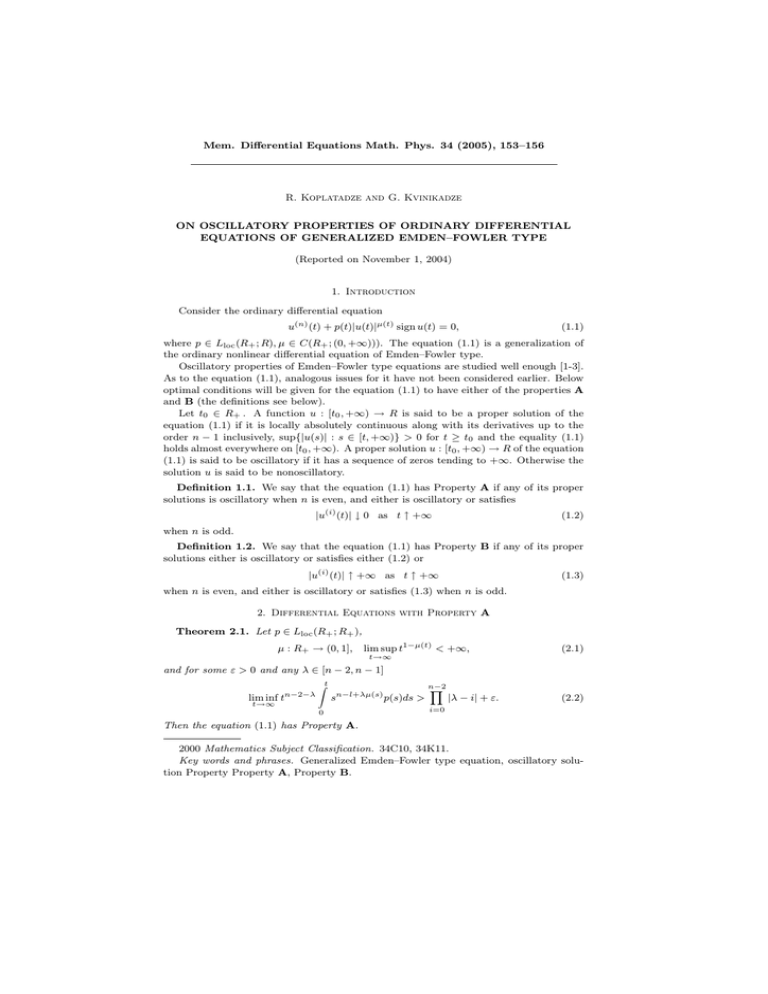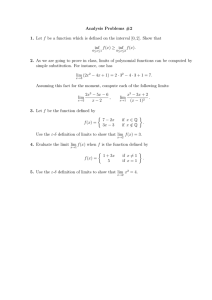Mem. Differential Equations Math. Phys. 34 (2005), 153–156
advertisement

Mem. Differential Equations Math. Phys. 34 (2005), 153–156
R. Koplatadze and G. Kvinikadze
ON OSCILLATORY PROPERTIES OF ORDINARY DIFFERENTIAL
EQUATIONS OF GENERALIZED EMDEN–FOWLER TYPE
(Reported on November 1, 2004)
1. Introduction
Consider the ordinary differential equation
u(n) (t) + p(t)|u(t)|µ(t) sign u(t) = 0,
(1.1)
where p ∈ Lloc (R+ ; R), µ ∈ C(R+ ; (0, +∞))). The equation (1.1) is a generalization of
the ordinary nonlinear differential equation of Emden–Fowler type.
Oscillatory properties of Emden–Fowler type equations are studied well enough [1-3].
As to the equation (1.1), analogous issues for it have not been considered earlier. Below
optimal conditions will be given for the equation (1.1) to have either of the properties A
and B (the definitions see below).
Let t0 ∈ R+ . A function u : [t0 , +∞) → R is said to be a proper solution of the
equation (1.1) if it is locally absolutely continuous along with its derivatives up to the
order n − 1 inclusively, sup{|u(s)| : s ∈ [t, +∞)} > 0 for t ≥ t0 and the equality (1.1)
holds almost everywhere on [t0 , +∞). A proper solution u : [t0 , +∞) → R of the equation
(1.1) is said to be oscillatory if it has a sequence of zeros tending to +∞. Otherwise the
solution u is said to be nonoscillatory.
Definition 1.1. We say that the equation (1.1) has Property A if any of its proper
solutions is oscillatory when n is even, and either is oscillatory or satisfies
|u(i) (t)| ↓ 0 as t ↑ +∞
(1.2)
when n is odd.
Definition 1.2. We say that the equation (1.1) has Property B if any of its proper
solutions either is oscillatory or satisfies either (1.2) or
|u(i) (t)| ↑ +∞ as t ↑ +∞
(1.3)
when n is even, and either is oscillatory or satisfies (1.3) when n is odd.
2. Differential Equations with Property A
Theorem 2.1. Let p ∈ Lloc (R+ ; R+ ),
µ : R+ → (0, 1],
lim sup t1−µ(t) < +∞,
(2.1)
t→∞
and for some ε > 0 and any λ ∈ [n − 2, n − 1]
lim inf tn−2−λ
t→∞
Zt
sn−l+λµ(s) p(s)ds >
0
n−2
Y
|λ − i| + ε.
(2.2)
i=0
Then the equation (1.1) has Property A.
2000 Mathematics Subject Classification. 34C10, 34K11.
Key words and phrases. Generalized Emden–Fowler type equation, oscillatory solution Property Property A, Property B.
154
Theorem 2.2. Let p ∈ Lloc (R+ ; R+ ), the condition (2.1) be fulfilled and there exist
ε > 0 such that for any λ ∈ [n − 2, n − 1]
lim inf t−1
t→∞
Zt
sn−λ+λµ(s) p(s)ds >
n−1
Y
|λ − i| + ε.
(2.3)
i=0
0
Then the equation (1.1) has Property A.
Theorem 2.3. Let p ∈ Lloc (R+ ; R+ ), the condition (2.1) be fulfilled and
lim inf t−1
t→∞
Zt
sn p(s)ds > max{γ −λ
n−1
Y
|λ − i| : λ ∈ [n − 2, n − 1]},
(2.4)
i=0
0
where γ = lim inf tµ(t)−1 . Then the equation (1.1) has Property A.
t→∞
Theorem 2.4. Let p ∈ Lloc (R+ ; R+ ),
µ : R+ → [1, +∞),
lim sup tµ(t)−1 < +∞
(2.5)
t→∞
and there exist ε > 0 such that when n is even for any λ ∈ [0, 1]
lim inf t−λ
t→+∞
Zt
n−1
Y
sn−1+λµ(s) p(s)ds >
|λ − i| + ε,
i=0;i6=1
0
while when n is odd the condition (2.2) is fulfilled for any λ ∈ [n − 2, n − 1] and the
condition
Zt
n−1
Y
lim inf t1−λ sn−2+λµ(s) p(s)ds >
|λ − i| + ε,
t→+∞
i=0;i6=2
0
for any λ ∈ [1, 2]. Then the equation (1.1) has Property A.
Theorem 2.5. Let p ∈ Lloc (R+ ; R+ ), the condition (2.5) be fulfilled and there exist
ε > 0 such that when n is even the condition (2.3) is fulfilled for any λ ∈ [0, 1], while
when n is odd the condition (2.3) is fulfilled for any λ ∈ [1, 2] ∪ [n − 2, n − 1]. Then the
equation (1.1) has Property A.
Theorem 2.6. Let p ∈ Lloc (R+ ; R+ ), the condition (2.5) be fulfilled, and when n is
even
Zt
n−1
Y
|λ − i| : λ ∈ [0, 1]},
(2.6)
lim inf t−1 sn p(s)ds > max{γ −λ
t→+∞
i=0
0
while when n is odd
lim inf t
t→+∞
−1
Zt
sn p(s)ds > max{γ −λ
n−1
Y
|λ − i|, λ ∈ [1, 2] ∪ [n − 2, n − 1]},
(2.7)
i=0
0
where γ = lim inf tµ(t)−1 . Then the equation (1.1) has Property A.
t→+∞
3. Differential Equations with Property B
Theorem 3.1. Let p ∈ Lloc (R+ ; R− ), the condition (2.1) be fulfilled and there exist
ε > 0 such that when n is even
lim inf tn−3−λ
t→+∞
Zt
0
s2+λµ(s) |p(s)|ds >
n−1
Y
i=0;i6=n−2
|λ − i| + ε
(3.1)
155
for any λ ∈ [n − 3, n − 2], while when n is odd the condition (3.1) is fulfilled for any
λ ∈ [0, 1] and the condition
lim inf t−λ
t→+∞
Zt
n−1
Y
sn−1+λµ(s) |p(s)|ds >
|λ − i| + ε
i=0;i=1
0
for any λ ∈ [n − 3, n − 2]. Then the equation (1.1) has Property B.
Theorem 3.2. Let p ∈ Lloc (R+ ; R− ), the condition (2.1) be fulfilled and there exist
ε > 0 such that when n is even
lim inf t−1
t→+∞
Zt
sn−λ+λµ(s) |p(s)|ds >
n−1
Y
|λ − i| + ε
(3.2)
i=0
0
for any λ ∈ [n − 3, n − 2], while when n is odd the condition (3.2) is fulfilled for any
λ ∈ [0, 1] ∪ [n − 3, n − 2]. Then the equation (1.1) has Property B.
Theorem 3.3. Let p ∈ Lloc (R+ ; R− ), the condition (2.1) be fulfilled and when n is
even
Zt
n−1
Y
lim inf t−1 sn |p(s)|ds > max{γ −λ
|λ − 1| : λ ∈ [n − 3, n − 2]},
(3.3)
t→+∞
i=0
0
while when n is odd
lim inf t−1
t→+∞
Zt
sn |p(s)|ds > max{γ −λ
n−1
Y
|λ − 1| : λ ∈ [0, 1] ∪ [n − 3, n − 2]},
(3.4)
i=0
0
where γ = lim inf tµ(t)−1 . Then the equation (1.1) has Property B.
t→+∞
Theorem 3.4. Let p ∈ Lloc (R+ ; R− ), the condition (2.5) be fulfilled and there exist
ε > 0 such that when n is even
lim inf t1−λ
t→+∞
Zt
sn−2+λµ(s) |p(s)|ds >
n−1
Y
|λ − 1| + ε
n−1
Y
|λ − i| + ε
i=0;i6=2
0
for any λ ∈ [1, 2], while when n is odd
lim inf t−λ
t→+∞
Zt
sn−1+λµ(s) |p(s)|ds >
0
i=0;i6=1
for any λ ∈ [0, 1]. Then the equation (1.1) has Property B.
Theorem 3.5. Let p ∈ Lloc (R+ ; R− ), the condition (2.5) be fulfilled and there exist
ε > 0 such that when n is even
lim inf t−1
t→∞
Zt
sn−λ+λµ(s) |p(s)|ds >
n−1
Y
|λ − i| + ε
(3.5)
i=0
0
for any λ ∈ [0, 1], while when n is odd the condition (3.5) is fulfilled for any λ ∈ [0, 1].
Then the equation (1.1) has Property B.
Theorem 3.6. Let p ∈ Lloc (R+ ; R− ), the condition (2.5) be fulfilled and when n is
even
Zt
n−1
Y
|λ − 1| : λ ∈ [1, 2]},
(3.6)
lim inf t−1 sn |p(s)|ds > max{γ −λ
t→+∞
0
i=0
156
while when n is odd
lim inf −1
t→+∞
Zt
sn |p(s)|ds > max{γ −λ
n−1
Y
|λ − 1| : λ ∈ [0, 1]},
(3.7)
i=0
0
where γ = lim inf tµ(t)−1 . Then the equation (1.1) has Property B.
t→+∞
It should be noted that the strict inequalities (2.4) in Theorem 2.3, (2.6)–(2.7) in
Theorem 2.6, (3.3)–(3.4) in Theorem 3.3, and (3.6)–(3.7) in Theorem 3.6 can not be
replaced by the non-strict ones.
References
1. I. T. Kiguradze and T. A. Chanturia, Asymptotic properties of solutions of
nonautonomous ordinary differential equations. (Translated from the Russian) Mathematics and its Applications (Soviet Series), 89. Kluwer Academic Publishers Group,
Dordrecht, 1993.
2. R. G. Koplatadze and T. A. Chanturia, Oscillation properties of differential
equations with deviating argument. Izdat. Tbilis. Univ., Tbilisi, 1977.
3. R. Koplatadze, On oscillatory properties of solutions of functional-differential
equations. Mem. Differential Equations Math. Phys. 3 (1994), 179 pp.
Authors’ address:
A. Razmadze Mathematical Institute
Georgian Academy of Sciences
1, Aleksidze St., Tbilisi 0193
Georgia
E-mail: roman@rmi.acnet.ge
giokvi@rmi.acnet.ge







